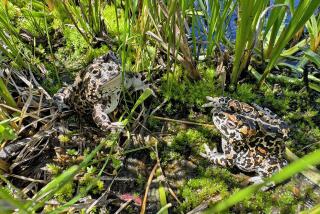‘Amphibian Ark’ is seen as species’ last best hope
- Share via
ATLANTA — Scientists from across the world gathered here Thursday to launch an “Amphibian Ark” for thousands of species of frogs, toads and salamanders threatened by a deadly fungus.
The ark project was envisaged as scientists came to realize that the amphibians could not be saved in the wild, said Kevin Zippel, the project’s amphibian program officer. The group is appealing to zoos, aquariums and botanical gardens across the world to construct special bio-secure facilities for 500 each of nearly 2,000 endangered amphibian species -- most of which are frogs.
After the frogs are collected, they would be cleaned to make sure they did not bring the fungus into the captive environments. It is estimated that that portion of the project will cost about $40 million.
The scientists estimate that their larger goal of researching how to save the species will cost 10 times that amount. They are establishing a global fundraising campaign and plan to designate 2008 “Year of the Frog.”
Scientists liken the crisis facing amphibians from the fungus and other causes to the extinction of dinosaurs: About 170 of the nearly 6,000 species of amphibians have become extinct in the last decade, and 2,000 more are threatened.
“This is a mass extinction never before seen in human history,” said Joseph Mendelson, curator of herpetology at Zoo Atlanta and executive director of the International Union for Conservation of Nature and Natural Resources’ amphibian specialist group. “From a purely cold-hearted scientific perspective, it’s a fascinating thing to document when we’re still guessing what happened to dinosaurs.”
Among the extinct species is the Costa Rican golden toad. The Panama golden frog and the Dominican mountain chicken frog are close to extinct. In California, about 85% of the 650 frog populations at Yosemite National Park are infected with the fungus.
Because their skin is so permeable, amphibians are particularly sensitive to new diseases and changes in the environment, such as climate change, pollution and deforestation.
The rapidly spreading deadly fungus -- the chytrid fungus -- was discovered and named as a new genus in 1998. It is a microscopic parasite that invades the surface layers of the frogs’ skin, making it difficult for them to use their pores and regulate water intake.
There is no evidence that the fungus could shift from amphibians to other organisms like mammals or plants, but the scientists who traveled to Zoo Atlanta from countries as diverse as Colombia, Australia, Germany and India argue that the plight of amphibians presents a warning for humans, as well as a crucial opportunity to learn.
One of the most abundant vertebrate groups, amphibians play a critical role in the ecosystem, functioning as a middle system in food chains.
Without amphibian tadpoles in streams in the cloud forests of Panama, a hyperprolific algae is spreading, affecting stream ecology and water chemistry. Meanwhile, predators such as snakes that rely on amphibians are slowly starving to death.
Amphibians also have significant biomedical value for humans: The skin of the Ecuadorean tricolor frog produces a pain reliever that is more powerful than morphine, without any addictive side effects; secretions from the Peruvian giant monkey frog are used to treat seizures and depression; antimicrobial peptides secreted from the Australian red-eyed tree frog’s skin are used to disable HIV infection.
“As they disappear, our medicine chest goes with them,” Mendelson said.
Amphibians have long been affected by habitat loss and pollution, but the fungus appears to be killing them at a faster rate, and in traditionally precious habitat.
According to the Global Amphibian Assessment, a comprehensive status assessment of the world’s 5,918 amphibian species, Colombia has 209 threatened amphibian species, the highest count, followed by Mexico, Ecuador, Brazil and China. The U.S. has 52 endangered amphibian species.
Scientists are not sure of the fungus’ origin. The Centers for Disease Control and Prevention recently published a study suggesting that it began in Africa. Researchers across the world are studying the African clawed frog, which carries the fungus on its skin but is immune to its fatal effects.
“Bringing [frogs] into an amphibian ark is really the last option,” said Kevin Buley, director of herpetology at Chester Zoo in England, and chair of the European Assn. of Zoos and Aquaria’s amphibian ark. “Everyone is aware of endangered pandas and tigers, but no one is making noise about these tiny creatures that have lived for 200 million years.”
If the thought of Kermit the Frog failed to inspire humans to take action, Buley argued there was a more pressing incentive.
“Think of them as the canaries in the coal mine,” he said.
More to Read
Sign up for Essential California
The most important California stories and recommendations in your inbox every morning.
You may occasionally receive promotional content from the Los Angeles Times.













